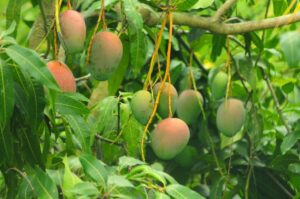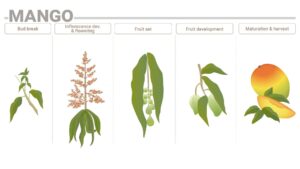The effects of pruning in combination with potassium nitrate or potassium thio-sulphate application on mango production were studied on the Maracaibo plain, Zulia State, Venezuela. A factorial design was used, with two treatments of pruning at two levels (without pruning and with pruning), two flowering inductor levels (potassium nitrate (KNO3) at 6% and potassium thio-sulphate at 1% (PTS)), and a control without pruning and without inductor (Figure 1). The treatments were located at random using two varieties: ‘Irwin’ and ‘Tommy Atkins’ with four plants per treatment. Two consecutive production seasons were studied considering early and late induction that means four essays over different plots.
The result compared to the untreated control showed 25 to 30 days earlier harvests for Irwin variety, and 15 to 20 days earlier harvest for Tommy Atkins variety, when potassium nitrate was applied. The application of the inductor shortened the total harvesting time. About 80% of production was concentrated in two initial months of harvesting when potassium nitrate was applied. For almost all treatments early induction resulted in higher yield levels compared to late induction. Results of this research showed that for the Irwin variety potassium nitrate combined with pruning resulted in the highest yield level, during both inductions, compared with other applied treatments (Figure 1). Pruning was more effective for Irwin variety, whereas no pruning gave better results in Tommy Atkins variety. It can be concluded that potassium nitrate seemed to be the preferred inductor compared to potassium thio-sulphate.

Figure 1. The effect of pruning and foliar application of potassium nitrate (KNO3) and potassium thio-sulphate (KTS) on the averaged yield (for two cropping seasons) of two mango varieties.



